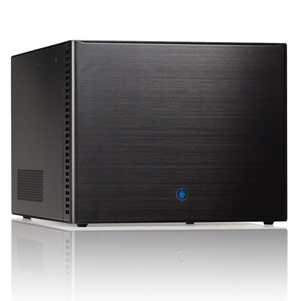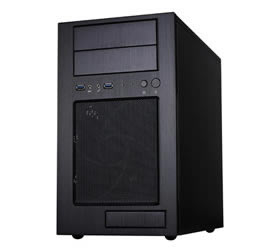File Server Builder's Guide
by Zach Throckmorton on September 4, 2011 3:30 PM ESTAs motherboard layout is important in ensuring that airflow is as unobstructed as possible, case design is also critical in facilitating excellent airflow. If you're building a system with one or two hard drives, most cases work fine for a home file server - just make sure there is a fan near the hard drive(s) so it is not sitting in stagnant air. However, if your server requires multiple disks, here are a few cases that work especially well for file servers.
Mini-ITX

Fractal's Array R2 is a nearly perfect home file server case. At less than 14" deep by 10" wide by 8" tall, it occupies little volume. It positions a removable hard drive cage immediately behind a quiet yet powerful 140mm intake fan. The hard drive cage accommodates up to six hard drives using vibration-dampening silicone mounts, and there is also room for a 2.5" drive (either an SSD or HDD). According to my testing, when stuffed with six low-rpm 2TB mass storage HDDs and one SSD (with an Intel Pentium G620 CPU installed), the temperatures of the HDDs hover around 40C even when all drives are under artificial sustained load (using Iometer). The PSU is a custom SFX form factor model, 80+ efficiency 300W unit with ample amps on the split 12V rail to power six HDDs. The PSU features seven SATA connectors and one legacy molex connector, so there are no extraneous molex plugs and enough SATA plugs. Furthermore, the cables are shorter than typical, so excessive cabling does not interfere with airflow. The case itself is constructed of aluminum so it is lightweight, and its overall build quality is very high. It does not have room for an optical drive, but I consider optical drives superfluous for a home file server. If necessary, you can always hook up a USB interface external optical drive. The only drawback of this case and its PSU is the price: at just under $200, it is not cheap. However, the subjective aesthetics, objective functionality of the case and the custom PSU are worth the cost if you want a small but capacious home file server case.
Micro-ATX

As I prefer home file servers that take up as little space as possible, Silverstone's TJ08B-E is a great, smaller micro-ATX minitower. It's less than 16" deep, 9" wide, 15" tall and weighs less than 12 pounds. It can accommodate up to five HDDs plus one SSD. As with the Fractal Array R2, the hard drives are placed immediately behind a front intake fan - though in this case, it's an even larger 180mm unit. The TJ08B-E is flexible in that it can hold a couple optical drives as well as a GPU in case you want to repurpose or multipurpose it. When stuffed with four low-rpm green drives, the temperatures under load don't exceed 45C during sustained transfers. Overall build quality is very good, like most Silverstone cases.
Silverstone makes a diminutive, fully modular PSU that makes working with smaller cases like the TJ08B-E, Lian Li PC-Q08, and others much easier. Silverstone also offers a short cable kit, making the ST50F-P PSU even better suited to SFF cases. Finally, it's clear that Silverstone had smaller multi-HDD systems in mind when designing the CP06 SATA power plug extension cable. This extender connects to a single SATA power plug and then has four SATA power plugs that are spaced closer than usual together, further reducing cable clutter. Though the cost of these accessories adds up, they make an ideal cabling solution very easy to implement. Regardless of whatever PSU you decide to go with, if you use a split 12V rail model, make sure you don't load up one rail with HDDs. If you go with a single 12V rail model, you'll want that rail to be beefy - for example, don't try to put ten HDDs and four case fans on a budget PSU with a 20A 12V rail.
Full Tower
Very few cases can accommodate ten HDDs at stock (without adding adapters), and such cases are not at all small. Full towers also typically offer excellent airflow, and cable management is not very difficult. Fractal's Define XL is one of the least expensive 10 HDD bay full tower cases available. It is well-built, and extra care has been paid to making the case quiet in the form of panel insulation. It is impossible to hear active HDDs inside this case even when you're sitting just a few feet from it (even the notoriously loud VelociRaptors). Further, there are plenty of integrated niceties like adjustable/flexible cable baffles that assist in cable management. Seven of the ten HDD slots are immediately behind fans, with three slots one cage removed from the front intake fans. Even still, the HDDs that aren't right behind the fans stay cool (between 35C and 40C). At around $150, it is an excellent value. Just make sure you don't pair it up with Silverstone's short cable kit!
We've saved the most important aspect of a home file server - the hard drives - for the next and last component page.











152 Comments
View All Comments
noxipoo - Sunday, September 4, 2011 - link
i'm looking for alternatives to drobo or the more expensive NAS devices so some raid card recommendations along with all the things that one needs would of been nice.bamsegrill - Sunday, September 4, 2011 - link
Yeah, some raidcard-recommendations would be nice.Rick83 - Sunday, September 4, 2011 - link
MY RAID card recommendation is a mainboard with as many SATA ports as possible, and screw the RAID card.For anything but high end database servers, it's a waste of money.
With desktop boards offering 10 to 12 SATA ports these days, you're unlikely to need additional hardware, if you chose the right board.
Otherwise, it's probably wisest to go with whatever chipset is best supported by your OS.
PCTC2 - Sunday, September 4, 2011 - link
But there's the fact that software RAID (which is what you're getting on your main board) is utterly inferior to those with dedicated RAID cards. And software RAIDs are extremely fickle when it comes to 5400 RPM desktop drives. Drives will drop out and will force you to rebuild... over 90 hours for 4 1.5TB drives. (I'm talking about Intel Storage Matrix on Windows/ mdadm on Linux).You could run FreeNAS/FreeBSD and use RAID-Z2. I've been running three systems for around 5 months now. One running Intel Storage Matrix on Windows, one running RAID-Z2 on FreeBSD, and one running on a CentOS box on a LSI2008-based controller. I have to say the hardware has been the most reliable, with the RAID-Z2 in a close second. As for the Intel softRAID, I've had to rebuild it twice in the 5 months (and don't say it's the drives because these drives used to be in the RAID-Z2 and they were fine. I guess Intel is a little more tight when it comes to drop-out time-outs).
A good RAID card with an older LSI1068E for RAID 5 is super cheap now. If you want a newer controller, you can still get one with an LSI2008 pretty cheap as well. If you want anything other than a giant RAID 0 stripe (such as RAID 5/6/10), then you should definitely go for a dedicated card or run BSD.
Rick83 - Sunday, September 4, 2011 - link
I've been using 5400 rpm disks and mdadm on linux for quite a while (6 years now?) and never had a problem, while having severly sufficient performance.If disks drop, that's the kernel saying that the device is gone, and could be jut a bad controller.
I've been on three boards and never had that kind of issue.
Windows is a bit more annoying.
Also, your rebuild time is over the top.
I've resynced much faster (2 hours for 400GB - so 10x faster than what you achieved. While also resyncing another array. Sounds like you may have a serious issue somewhere)
The compatibility advantage of software RAID outweighs any performance gain, unless you really need those extra 10 percent, or run extreme arrays (RAID-6 over 8 disks, and I might consider going with a dedicated card)
I think it might be the Intel/Windows combination that is hurting you - you might want to try the native windows RAID over the Intel Matrix stuff. Using that is the worst of both worlds, as you have the vendor lock in off a dedicated card and the slightly lower performance of a software solution.
Of course, you also mentioned mdadm, but I've never had a problem with that, with a bunch of different disks and controllers and boards.
I guess in two to three years, when I upgrade my machine again, I will have to look at a SATA controller card, or maybe sooner, should one of my IDE disks fail without me being able to replace it.
I think you may just have been unlucky with your issues, and can't agree with your assessment :-/
Flunk - Sunday, September 4, 2011 - link
I agree, I've used the Windows soft raid feature a lot and it trumps even hardware raid for ease of use because if your raid controller dies you can just put your drives in any windows system and get your data off. You don't need to find another identical controller. Performance is similar to matrix raid, good enough for a file server.vol7ron - Monday, September 5, 2011 - link
Wouldn't a RAID card be limited to the PCI bus anyhow? I would suspect you'd want the full speed that the SATA ports are capable ofvol7ron - Monday, September 5, 2011 - link
Even with 5400RPM drives, if you have a lot of data you're copying/transfering, you could probably saturate the full bandwidth, right?Rick83 - Monday, September 5, 2011 - link
PCI is wide enough to support gigabit ethernet, so if you don't have too many devices on the bus, you'll be fine until you have to build a RAID array.With PCI-X and PCIe these limitations are no longer of relevance.
Jaybus - Monday, September 5, 2011 - link
There are plenty of PCI-E x4 and x8 RAID cards.